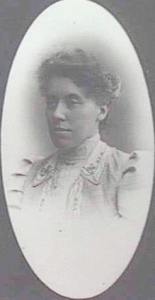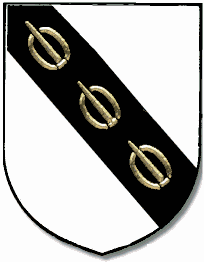Harriet Adelaide Stirling OBE (1878-1943) [1]
 Harriet Adelaide Stirling was the eldest daughter of Edward Charles and Jane Stirling (née Gilbert). Harriet’s father was a remarkable scholar who played a successful role in South Australian medicine, science and politics. EC Stirling helped to found the Medical School at the University of Adelaide, founded the Adelaide Museum and participated in many significant 19th century expeditions for the Museum. He was also a great supporter of the rights of women, and was the first person in Australasia to introduce a bill for women’s suffrage. He became the North Adelaide Member of the House of Assembly in 1884, and in the following year he moved a motion for women’s suffrage. Then in 1886 he introduced a bill for women’s suffrage into the South Australian parliament. Although this bill was not passed, it presumably prepared the way for the similar bill which was passed in 1894. Not only was EC Stirling committed to the political rights of women, but he also believed in their right to a proper education. He lectured at the Advanced School for Girls, and also campaigned for women to be admitted to Adelaide University’s School of Medicine.[2]
Harriet Adelaide Stirling was the eldest daughter of Edward Charles and Jane Stirling (née Gilbert). Harriet’s father was a remarkable scholar who played a successful role in South Australian medicine, science and politics. EC Stirling helped to found the Medical School at the University of Adelaide, founded the Adelaide Museum and participated in many significant 19th century expeditions for the Museum. He was also a great supporter of the rights of women, and was the first person in Australasia to introduce a bill for women’s suffrage. He became the North Adelaide Member of the House of Assembly in 1884, and in the following year he moved a motion for women’s suffrage. Then in 1886 he introduced a bill for women’s suffrage into the South Australian parliament. Although this bill was not passed, it presumably prepared the way for the similar bill which was passed in 1894. Not only was EC Stirling committed to the political rights of women, but he also believed in their right to a proper education. He lectured at the Advanced School for Girls, and also campaigned for women to be admitted to Adelaide University’s School of Medicine.[2]
Coming from an influential and successful family and having such an intelligent and liberal father provided many advantages for Harriet. She had access to an excellent education and encouraged to pursue a wide range of interests. She was born in London in 1878, and in 1881 her parents took her and her two younger sisters back to their native South Australia, where they lived first in North Adelaide, and then later at their beautiful house, St Vigeans, near Stirling in the Adelaide Hills. The girls (eventually five of them) were taught at home by a well-respected German governess.
Although Harriet never married or had any children of her own, she devoted herself to the welfare of children. In this she was certainly inspired by her father, who had worked as a surgeon at the Belgrave Hospital for Children in London and always maintained an interest in paediatrics during his career as Professor of Physiology at Adelaide University. She also loved helping with her younger brothers and sisters. Harriet’s eldest nephew remembered her as being a kind and gentle women who always gave generously of herself to those in need.
Harriet numbered among her friends many influential South Australian women, including Catherine Helen Spence and Dr Helen Mayo. Spence formed the State Children’s Council with support from Harriet Stirling, whose father was its first President. Harriet herself was a member of the Council from 1907, and she served as its President from 1922 to 1926. Some of the orphaned wards of State were taken under her wing at her family’s St Vigeans property.
On 12 February 1914, Harriet was appointed an ‘Honorary Commissioner to inquire into and report upon the question of the Control and Management of State and Neglected Children in Great Britain and on the Continent of Europe’. In that capacity she wrote a paper titled ‘A review of some of the agencies in use in saving child life in South Australia’.
Harriet was also passionate about the education, support and health of women. In 1909, she and her friend Dr Helen Mayo jointly founded the School for Mothers. Earlier that year, Dr Mayo had presented a paper on infant mortality which raised general awareness of many of the problems faced by mothers. A visit and lecture by a worker from the St Pancreas School for Mothers in London inspired Harriet and Dr Mayo to form their own school in Adelaide. The school proved successful, and in 1927 became the Mothers and Babies’ Health Association, [3] a body which is much valued to this day.
Another serious concern for Harriet and Dr Mayo was that children under two were not admitted to the Adelaide Children’s Hospital! (apparently due to the risk of infection – they were only allowed in for the period of necessary surgery). From 1913, the two of them campaigned for a babies’ ward to be added to the Children’s Hospital, and when their request was refused they established their own hospital for babies in 1914. This was later taken over by the Government and relocated to Woodville, becoming the Mareeba Babies’ Hospital in 1917. Harriet was actively involved with the framing of the policy for this hospital, as well as serving as its secretary.
Harriet lived in the family home of St Vigean’s until her widowed mother died and the house was sold, at which time she established her own home, Brothock, nearby. She then lived there until her death in 1943. Her efforts for the mothers and babies of South Australia made a significant contribution to the health and well-being of countless South Australians. Her dedication to this important work earned her an OBE in the early 20th century.
- Written by Anna Stirling Pope, Goodwood, South Australia September 2000
- Family records held by AS Pope – files: ‘Stirling, Harriet Adelaide’.
- Mothers and Babies’ Health Association Inc. 59th Annual Report, June 1968, pp 7-8.
- Stirling, Harriet A, [undated], ‘A review of some of the agencies in use in saving child life in South Australia’, 11-page typescript, SA Archives PRG 388.
- Oral history: ES Booth (SOHC/MLSA OH295).
- Advertiser, 26 September 1984, p 6.
- Mt Barker Courier, 26 May 1982, p 4.
- The Medical Journal of Australia, 1968, 1: 368 (2 March) and 738 (27 April).
- Duncan, WGK 1973, The University of Adelaide 1874-1974, Rigby, p 64.
